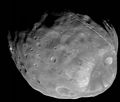Fail:Phobos colour 2008.jpg

Selle eelvaate suurus: 636 × 600 pikslit. Teised eraldusvõimed: 255 × 240 pikslit | 509 × 480 pikslit | 815 × 768 pikslit | 1086 × 1024 pikslit | 2172 × 2048 pikslit | 3500 × 3300 pikslit.
Algfail (3500 × 3300 pikslit, faili suurus: 2,72 MB, MIME tüüp: image/jpeg)
Faili ajalugu
Klõpsa kuupäeva ja kellaaega, et näha sel ajahetkel kasutusel olnud failiversiooni.
| Kuupäev/kellaaeg | Pisipilt | Mõõtmed | Kasutaja | Kommentaar | |
|---|---|---|---|---|---|
| viimane | 2. aprill 2018, kell 06:10 |  | 3500 × 3300 (2,72 MB) | Kaldari | more margin on right side |
| 13. november 2008, kell 07:47 |  | 3374 × 3300 (2,7 MB) | Fir0002 | == Summary == {{Information |Description=Colour image of Phobos, imaged by the Mars Reconnaisance Orbiter in 2008 |Source=NASA |Date=9 April 2008 |Location=http://www.nasa.gov/mission_pages/MRO/multimedia/pia10368.html |Author=NASA/J |
Faili kasutus
Seda faili kasutavad järgmised 3 lehekülge:
Globaalne failikasutus
Järgmised muud vikid kasutavad seda faili:
- Faili kasutus vikis af.wikipedia.org
- Faili kasutus vikis an.wikipedia.org
- Faili kasutus vikis ar.wikipedia.org
- المريخ
- فوبوس
- قمرا المريخ
- ويكيبيديا:صور مختارة/الفضاء والكون/نظرة إلى الأعلى
- قائمة أجرام المجموعة الشمسية مرتبة حسب الحجم
- بوابة:علم الفلك/صورة مختارة
- بوابة:المريخ
- بوابة:المريخ/مقالة مختارة/أرشيف
- بوابة:المريخ/مقالة مختارة/2
- قائمة الأقمار الطبيعية
- خط زمني لاكتشاف كواكب المجموعة الشمسية وأقمارها
- ويكيبيديا:ترشيحات الصور المختارة/القمر فوبوس
- ويكيبيديا:صورة اليوم المختارة/أغسطس 2019
- قالب:صورة اليوم المختارة/2019-08-03
- بوابة:علم الفلك/صورة مختارة/73
- معسكر قاعدة المريخ
- ويكيبيديا:صورة اليوم المختارة/يناير 2022
- قالب:صورة اليوم المختارة/2022-01-04
- Faili kasutus vikis ary.wikipedia.org
- Faili kasutus vikis arz.wikipedia.org
- Faili kasutus vikis as.wikipedia.org
- Faili kasutus vikis azb.wikipedia.org
- Faili kasutus vikis az.wikipedia.org
- Faili kasutus vikis be-tarask.wikipedia.org
- Faili kasutus vikis be.wikipedia.org
- Faili kasutus vikis bg.wikipedia.org
- Faili kasutus vikis bh.wikipedia.org
- Faili kasutus vikis bn.wikipedia.org
- Faili kasutus vikis bn.wikibooks.org
- Faili kasutus vikis bs.wikipedia.org
Vaata selle faili globaalset kasutust.





